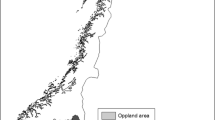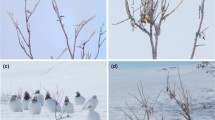Abstract
Browsing is one of the main factors determining survival, growth rate, woodland structure, and distribution of the high mountain tree Polylepis australis. This species has a substantial regrowth capacity, which may function as a mechanism to tolerate herbivory, but it is unknown to what extent it may compensate for the impact of herbivory. In 15 low-density tree stands subject to exclusion, moderate, and heavy livestock pressure, we selected 12 P. australis individuals <2 m tall, tagged four new shoots per tree and measured shoot length every month during a year. At the stand and at the tree level, we analyzed monthly dynamics of growth and browsing, and the annual output in terms of total browsing and total gross and net growth (not discounting and discounting consumption, respectively). In addition, we assessed the influence of stand, tree and microsite characteristics on growth and browsing patterns. Polylepis australis fully compensated for herbivory in terms of shoot gross growth at moderate, but not at heavy livestock pressure. In terms of net growth, this species did not fully compensate for herbivory at any stocking rate. We found a strong coupling between browsing and growth along the year, suggesting that regrowth attracts browsing, and browsing promotes regrowth. At the stand level, annual gross growth was not affected by habitat characteristics, while at the tree level, annual gross growth decreased on more rocky microsites for browsed but not for unbrowsed trees. We concluded that stocking densities should be limited to allow for a reasonable annual net growth, as its nitrogen rich leaves are a valuable food resource and P. australis forests provide important ecosystem services.



Similar content being viewed by others
References
Administración de Parques Nacionales (2007) Plan de manejo parque Nacional Quebrada del Condorito y Reserva Hídrica Provincial de Achala. Editorial APN, Argentina
Agrawal AA (2000) Overcompensation of plants in response to herbivory and the by-product benefits of mutualism. Trends Plant Sci 7:309–313
Asner GP, Elmore AJ, Olander LP, Martin RE, Harris AT (2004) Grazing systems, ecosystem responses, and global change. Annu Rev Environ Resour 29:261–299
Bee JN, Kunstler G, Coomes DA (2007) Resistance and resilience of New Zealand tree species to browsing. J Ecol 95:1014–1026
Belsky AJ (1986) Does herbivory benefit plants? A review of the evidence. Am Nat 127:870–892
Belsky AJ, Carson WP, Jensen CL, Fox GA (1993) Overcompensation by plants: herbivore optimization or red herring? Evol Ecol 7:109–121
Briske DD (1993) Grazing optimization: a plea for a balanced perspective. Ecol Appl 3:24–26
Bulinski J, Mc Arthur C (2003) Identifying factors related to the severity of mammalian browsing damage in eucalypt plantations. For Ecol Manag 183:239–247
Cabido M, Acosta A (1985) Estudio fitosociológico en bosques de Polylepis australis BITT. (“Tabaquillo”) en las sierras de Córdoba, Argentina. Doc Phytosociol 9:385–400
Chakeredza S, Hove L, Akinnifesi FA, Franzel S, Ajayi O, Sileshi G (2007) Managing fodder trees as a solution to human-livestock food conflicts and their contribution to income generation for smallholder farmer in Southern Africa. Nat Resour Forum 31:286–296
Chapin SF III, Autumm K, Pugnaire F (1993) Evolution of suites of traits in response to environmental stress. Am Nat 142:S79–S92
Cierjacks A, Hensen I (2004) Variation of stand structure and regeneration of Mediterranean holm oak along a grazing intensity gradient. Plant Ecol 173:215–223
Cingolani AM, Cabido MR, Renison D, Solís Neffa V (2003) Combined effects of environment and grazing on vegetation structure in Argentine granite grasslands. J Veg Sci 14:223–232
Cingolani AM, Renison D, Zak MR, Cabido MR (2004) Mapping vegetation in a heterogeneous mountain rangeland using landsat data: an alternative method to define and classify land-cover units. Remote Sens Environ 92:84–97
Cingolani AM, Noy-Meir I, Diaz S (2005a) Grazing effects on rangeland diversity: a synthesis of contemporary models. Ecol Appl 15:757–773
Cingolani AM, Posse G, Collantes MB (2005b) Plant functional traits, herbivore selectivity and response to sheep grazing in Patagonian steppe grasslands. J Appl Ecol 42:50–59
Cingolani AM, Renison D, Tecco PA, Gurvich DE, Cabido M (2008) Predicting cover types in a mountain range with long evolutionary grazing history: a GIS approach. J Biogeogr 35:538–551
Colladon L (2000) Anuario pluviométrico 1992–2000. Cuenca del río San Antonio. Sistema del río Suquia-provincia de Córdoba. Instituto Nacional del Agua y del Ambiente (INAA) y Centro de Investigaciones de la Región Semiárida (CIRSA), Cordoba, Argentina
Danell K, Bergströn R, Edenius L, Ericsson G (2003) Ungulates as drivers of tree population dynamics at module and genet level. For Ecol Manag 181:67–76
Díaz S, Acosta A, Cabido M (1994) Community structure in montane grasslands of central Argentina in relation to land use. J Veg Sci 5:483–488
Evans DM, Redpath SM, Elston DA, Evans SA, Mitchell RJ, Dennis P (2006) To graze or not to graze? Sheep, voles, forestry and nature conservation in the British uplands. J Appl Ecol 43:499–505
Falczuk V (2002) Relaciones entre selección de dieta de grandes herbívoros, disponibilidad y características físico-químicas de las plantas en un pastizal de altura de las Sierras de Córdoba. Graduation Thesis. UNC, Argentina
Focardi S, Tinelli A (2005) Herbivory in a Mediterranean forest: browsing impact and plant compensation. Acta Oecol 28:239–247
Gordon IJ (2003) Browsing and grazing ruminants: are they different beasts? For Ecol Manag 181:13–21
Greene DF, Johnson DA (1994) Estimating the mean annual seed production of trees. Ecology 75:642–647
Guillet C, Bergström R (2006) Compensatory growth of fast-growing willow (Salix) coppice in response to simulated large herbivore browsing. Oikos 113:33–42
Harmer R (2001) The effect of plant competition and simulated summer browsing by deer on tree regeneration. J Appl Ecol 38:1094–1103
Heuze P, Schnitzler A, Klein F (2005) Is browsing the major factor of silver fir decline in the Vosges Mountains of France? For Ecol Manag 217:219–228
Hunter ML (1990) Wildlife, forests and forestry: principles of managing forests for biological diversity. Prentice Hall, Englewood Cliffs, NJ
Katjiua MLJ, Ward D (2006) Resistance and tolerance of Terminalia sericea trees to simulated herbivore damage under different soil nutrient and moisture conditions. J Chem Ecol 32:1431–1443
Lennartsson T, Nilsson P, Tuomi J (1998) Induction of overcompensation in the field gentian, Gentianella campestris. Ecology 79:1061–1072
Lindroth RL, Donaldson JR, Stevens MT, Gusse AC (2007) Browse quality in quaking aspen (Populus tremuloides): effects of genotype, nutrients, defoliation, and coppicing. J Chem Ecol 33:1049–1064
Marcora P, Hensen I, Renison D, Seltmann P, Wesche K (2008) The performance of Polylepis australis trees along their entire altitudinal range: implications of climate change for their conservation. Divers Distrib 14:630–636
Massei G, Hartley SE, Bacon PJ (2000) Chemical and morphological variation of Mediterranean woody evergreen species: do plants respond to ungulate browsing? J Veg Sci 11:1–8
McNaughton SJ (1979) Grazing as an optimization process: grass-ungulate relationships in the Serengeti. Am Nat 113:691–703
McNaughton SJ (1983) Compensatory plant growth as a response to herbivory. Oikos 40:329–336
Medina M, Rivero D (2009) Alcances y limitaciones de la osteometría de camélidos en contextos arqueológicos de las Sierras Centrales de Argentina. In: Izeta A, Mengoni Goñalons G (eds) De la Puna a las Sierras: avances y perspectivas en Zooarqueología. British Archaeological Records (BAR) International Series, Oxford
Motta R (2003) Ungulate impact on rowan (Sorbus aucuparia L.) and Norway spruce (Picea abies (L.) Karst.) height structure in mountain forest in the eastern Italian Alps. For Ecol Manag 181:139–150
Noy-Meir I (1993) Compensating growth of grazed plants and its relevance to the use of rangelands. Ecol Appl 3:32–34
Ordóñez JL, Retana J, Espelta JM (2005) Effects of tree size, crown damage, and tree location on post-fire survival and cone production of Pinus nigra trees. For Ecol Manag 206:109–117
Paige KN (1992) Overcompensation in response to mammalian herbivory: from mutualistic to antagonistic interactions. Ecology 73:2076–2085
Persson I-L, Bergstrom R, Danell K (2007) Browse biomass production and regrowth capacity after biomass loss in deciduous and coniferous trees: responses to moose browsing along a productivity gradient. Oikos 116:1639–1650
Pietrzykowski E, McArthur C, Fitzgerald H, Goodwin AN (2003) Influence of patch characteristics on browsing of tree seedlings by mammalian herbivores. J Appl Ecol 40:458–469
Pollice J (2007) Influencia del tamaño de la planta madre y la ganadería sobre la productividad de semillas en Polylepis australis BITT. Graduation Thesis. UNC, Argentina
Pollock ML, Milner JM, Waterhouse A, Holland JP, Legg CJ (2005) Impacts of livestock in regenerating upland birch woodlands in Scotland. Biol Conserv 123:443–452
Pucheta E, Cabido M, Díaz S, Funes G (1998) Floristic composition, biomass, and aboveground net plant production in grazed and protected sites in a mountain grassland of central Argentina. Acta Oecol 19:97–105
Rao SJ, Iason GR, Hulbert IAR, Elston DA, Racey PA (2003) The effect of sapling density, heather height and season on browsing by mountain hares on birch. J Appl Ecol 40:626–638
Renison D, Cingolani AM, Suarez R (2002) Efectos del fuego sobre un bosquecillo de Polylepis australis (Rosaceae) en las montañas de Córdoba, Argentina. Rev Chil Hist Nat 75:719–727
Renison D, Hensen I, Cingolani A (2004) Anthropogenic soil degradation affects seed viability in Polylepis australis mountain forests of central Argentina. For Ecol Manag 196:327–333
Renison D, Cingolani AM, Suarez R, Menoyo E, Coutsiers C, Sobral A, Hensen I (2005) The restoration of degraded mountain woodlands: effects of seed provenance and microsite characteristics on Polylepis australis seedling survival and growth in Central Argentina. Restor Ecol 13:129–135
Renison D, Hensen I, Suarez R, Cingolani A (2006) Cover and growth habit of Polylepis woodlands and shrublands in the mountains of central Argentina: human or environmental influence? J Biogeogr 33:876–887
Rosenthal JP, Kothanen PM (1994) Terrestrial plant tolerance to herbivory. Trends Ecol Evol 9:145–148
Schmid B, Weiner J (1993) Plastic relationships between reproductive and vegetative mass in Solidago altissima. Evolution 7:61–74
Stevens MT, Waller DM, Lindroth RL (2007) Resistance and tolerance in Populus tremuloides: genetic variation, costs, and environmental dependency. Evol Ecol 21:829–847
Stevens MT, Kruger EL, Lindroth RL (2008) Variation in tolerance to herbivory is mediated by differences in biomass allocation in aspen. Func Ecol 22:40–47
Stowe KA, Marquis RJ, Hochwender CG, Simms EL (2000) The evolutionary ecology of tolerance to consumer damage. Annu Rev Ecol Syst 31:565–595
Strauss SY, Agrawal AA (1999) The ecology and evolution of plant tolerance to herbivory. Trends Ecol Evol 14:179–185
Teich I (2006) Variación estacional del ramoneo y su efecto en el crecimiento del tabaquillo (Polylepis australis Bitt.) en las montañas de Córdoba, Argentina. Graduation Thesis. UBA, Argentina
Teich I, Cingolani AM, Renison D, Hensen I, Giorgis MA (2005) Do domestic herbivores retard Polylepis australis woodland recovery in the mountains of Córdoba, Argentina? For Ecol Manag 219:229–241
van der Heyden F, Stock WD (1996) Regrowth of semiarid shrub following simulated browsing: the role of reserve carbon. Func Ecol 10:647–653
Vandenberghe C, Freléchoux F, Moravie M-A, Gadallah F, Buttler A (2007) Short-term effects of cattle browsing on tree sapling growth in mountain wooded pastures. Plant Ecol 188:253–264
Vendramini F, Díaz S, Pérez Harguindeguy N, Cabido M, Llano-Sotelo JM, Castellanos A (2000) Composición química y caracteres foliares en plantas de distintos tipos funcionales del centro-oeste de Argentina. Kurtziana 28:181–193
Weltzin JE, Archer SR, Heitschmidt RK (1998) Defoliation and woody plant (Prosopis glandulosa) seedling regeneration: potential vs realized herbivory tolerance. Plant Ecol 138:127–135
Wise MJ, Abrahamson WG (2007) Effects of resource availability on tolerance of herbivory: a review and assessment of three opposing models. Am Nat 169:443–454
Acknowledgments
We are grateful to the Volkswagen Foundation, Germany, Inter-American Institute for Global Change Research (IAI) CRN 2005, and CONICET which funded this study; to E. Galli, and to the National Park Quebrada del Condorito personnel. First author is a Fellow of CONICET and a Ph.D. student at the National University of Córdoba. Comments from two anonymous reviewers greatly improved this manuscript.
Author information
Authors and Affiliations
Corresponding author
Rights and permissions
About this article
Cite this article
Giorgis, M.A., Cingolani, A.M., Teich, I. et al. Do Polylepis australis trees tolerate herbivory? Seasonal patterns of shoot growth and its consumption by livestock. Plant Ecol 207, 307–319 (2010). https://doi.org/10.1007/s11258-009-9674-4
Received:
Accepted:
Published:
Issue Date:
DOI: https://doi.org/10.1007/s11258-009-9674-4




